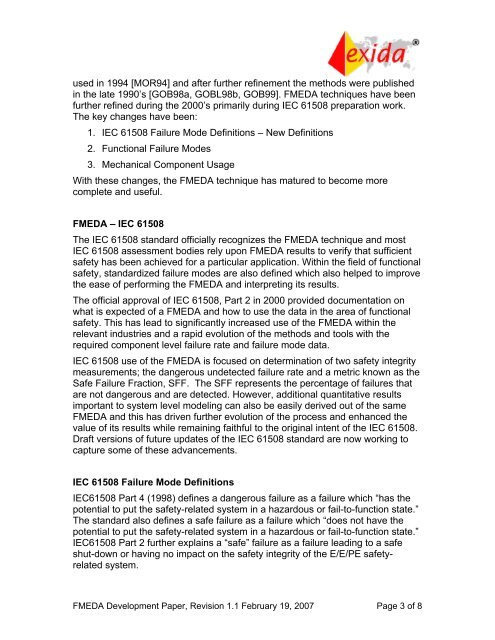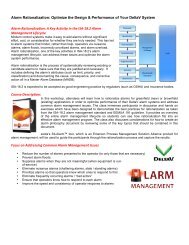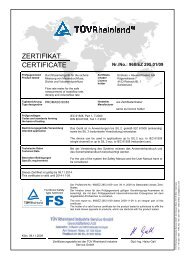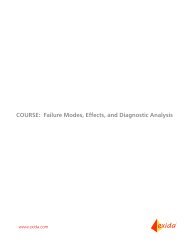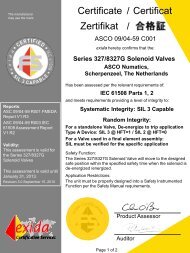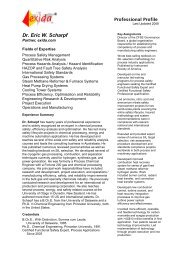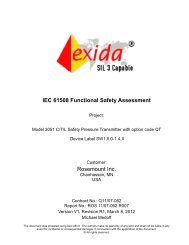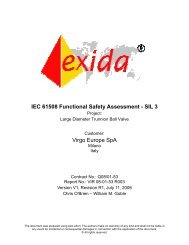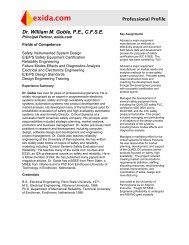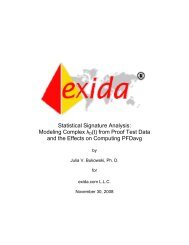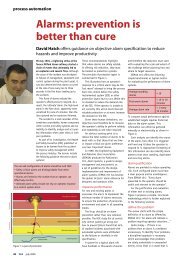FMEDA â Accurate Product Failure Metrics - Exida
FMEDA â Accurate Product Failure Metrics - Exida
FMEDA â Accurate Product Failure Metrics - Exida
- No tags were found...
You also want an ePaper? Increase the reach of your titles
YUMPU automatically turns print PDFs into web optimized ePapers that Google loves.
used in 1994 [MOR94] and after further refinement the methods were publishedin the late 1990’s [GOB98a, GOBL98b, GOB99]. <strong>FMEDA</strong> techniques have beenfurther refined during the 2000’s primarily during IEC 61508 preparation work.The key changes have been:1. IEC 61508 <strong>Failure</strong> Mode Definitions – New Definitions2. Functional <strong>Failure</strong> Modes3. Mechanical Component UsageWith these changes, the <strong>FMEDA</strong> technique has matured to become morecomplete and useful.<strong>FMEDA</strong> – IEC 61508The IEC 61508 standard officially recognizes the <strong>FMEDA</strong> technique and mostIEC 61508 assessment bodies rely upon <strong>FMEDA</strong> results to verify that sufficientsafety has been achieved for a particular application. Within the field of functionalsafety, standardized failure modes are also defined which also helped to improvethe ease of performing the <strong>FMEDA</strong> and interpreting its results.The official approval of IEC 61508, Part 2 in 2000 provided documentation onwhat is expected of a <strong>FMEDA</strong> and how to use the data in the area of functionalsafety. This has lead to significantly increased use of the <strong>FMEDA</strong> within therelevant industries and a rapid evolution of the methods and tools with therequired component level failure rate and failure mode data.IEC 61508 use of the <strong>FMEDA</strong> is focused on determination of two safety integritymeasurements; the dangerous undetected failure rate and a metric known as theSafe <strong>Failure</strong> Fraction, SFF. The SFF represents the percentage of failures thatare not dangerous and are detected. However, additional quantitative resultsimportant to system level modeling can also be easily derived out of the same<strong>FMEDA</strong> and this has driven further evolution of the process and enhanced thevalue of its results while remaining faithful to the original intent of the IEC 61508.Draft versions of future updates of the IEC 61508 standard are now working tocapture some of these advancements.IEC 61508 <strong>Failure</strong> Mode DefinitionsIEC61508 Part 4 (1998) defines a dangerous failure as a failure which “has thepotential to put the safety-related system in a hazardous or fail-to-function state.”The standard also defines a safe failure as a failure which “does not have thepotential to put the safety-related system in a hazardous or fail-to-function state.”IEC61508 Part 2 further explains a “safe” failure as a failure leading to a safeshut-down or having no impact on the safety integrity of the E/E/PE safetyrelatedsystem.<strong>FMEDA</strong> Development Paper, Revision 1.1 February 19, 2007 Page 3 of 8


